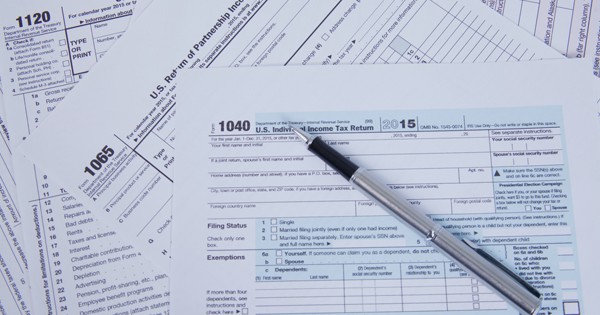Updated for 2024.
When you file an annual tax return, it’s easy to get overwhelmed by the sheer amount of tax forms available. To help you break it down, we picked out seven of the top Internal Revenue Service (IRS) tax forms you might need to know about this year and what they mean.
At a glance:
- Form W-2 and various 1099 forms are commonly used to report income.
- Sometimes, Schedules A or C must be filed along with the typical Form 1040.
- Tax forms can change from year to year, so always ensure you are using the updated versions.
1. Form 1040, U.S. Individual Tax Return
Form 1040 is the basic IRS tax form most U.S. filers use for annual tax returns. You might have to use this form depending on your age, filing status, and gross income. Even if you have no taxable income but are eligible for a tax refund or credit, this might be the correct form for you. It also allows you to itemize deductions and claim numerous expenses and tax credits.
There used to be a shortened version of this form available, Form 1040-EZ, Income Tax Return for Single and Joint Filers With No Dependents. However, this form was discontinued in tax year 2018 and the IRS no longer uses it.
2. Form W-4, Employee’s Withholding Allowance Certificate
You don’t file Form W-4 with your annual tax return or send it to the IRS. Instead, you give it to your employer to instruct them on how much tax to withhold from your gross paycheck and remit to the taxing authorities. Form W-4 includes a worksheet to help you calculate the amount. If you want assistance determining how much tax to withhold from your paycheck depending on your goals, give our W-4 calculator1 a try.
You file a new W-4 if you change employers. You can also file a new Form W-4 with your current employer if your circumstances change, for example, if you get married or have a baby and want to claim an additional dependent.
3. Form W-2, Wage and Tax Statement
People often confuse Form W-4 and Form W-2. Your employer gives you Form W-2 at the end of the calendar year to show the total amount of tax they withheld from your paychecks.
Your employer also provides a copy of the Form W-2 to the IRS, Social Security Administration, and some state taxing authorities. These taxing entities match the amounts you claim as income with the amounts your employer reports they paid you. Because your employer sends this form to the IRS, you do not need to file it with your tax return, but it will help you accurately report your taxable income.
4. Schedule A to Form 1040, Itemized Deductions
You may have heard that certain personal expenses can be “deducted” from your gross income to possibly reduce the amount of taxes you owe. This is true. If your total deductible personal expenses exceed the standard deduction set by the IRS, you can itemize your deductions using Schedule A.
Schedule A has seven categories of expenses, including charitable donations, medical expenses, and mortgage interest. Strict rules apply for calculating and claiming these deductions, however. Sometimes, you might not be able to deduct the full amount.
You also don’t have to complete every line of the schedule. If you don’t have expenses in a certain category, simply skip over it. Once you’re finished, add your total deduction amount to Form 1040.
5. Form 1099-INT, Interest Income
You might receive a Form 1099-INT from banks or other financial institutions if they paid you a certain amount of interest on your deposits. In many cases, you’ll have to pay tax on the interest and report it on your income tax return.
All amounts listed on the form need to be added to your return. You’ll also typically use Schedule B to list the name of each payer and the amount of interest received if the total taxable interest is over the $1,500 threshold.
6. Schedule C to Form 1040, Profit or Loss From Business (Sole Proprietorship)
If you are self-employed, you may need to file Schedule C to report your business’s gross profit or loss. Expenses include insurance, travel, business meals, taxes, office supplies, wages, and other business-related items.
7. Form 1099-NEC, Nonemployee Compensation
Self-employed people generally receive a Form 1099-NEC from each client that pays them throughout the year. It reports the total earnings received, and you must report that income on your tax return. As a freelancer or independent contractor, this form replaces a Form W-2 you would receive working for a traditional employer.
Before 2020, non-employee compensation was reported to self-employed taxpayers on Form 1099-MISC. This form is still around but is no longer used to report non-employee pay. Instead, Form 1099-MISC is used as a catch-all for other types of miscellaneous income such as rents, prizes, awards, medical and health payments, and fishing boat proceeds.
The bottom line
No matter which forms you must file, always make sure you use the correct tax year versions, as the IRS can update forms yearly. Also, remember that your personal situation may change, and you might need to file more or fewer forms each year, depending on your situation.
Thankfully, TaxAct® is here to make the tax filing process as painless as possible. If you file with us, we’ll take you through a Q&A, pull any necessary tax forms, and fill out the forms for you based on your answers and current tax situation.

